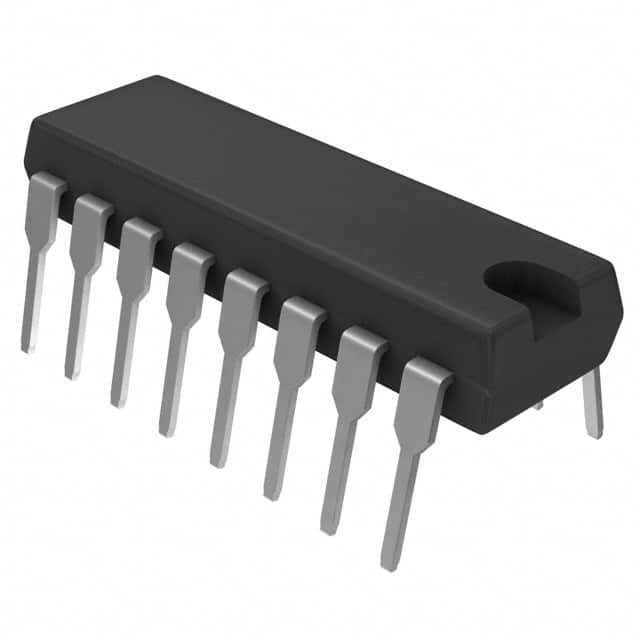Vedi le specifiche per i dettagli del prodotto.

Encyclopedia Entry: 74VHC595N
Product Overview
Category
The 74VHC595N is a digital integrated circuit (IC) belonging to the category of shift registers.
Use
This IC is primarily used for serial-to-parallel data conversion and parallel-to-serial data conversion in various electronic applications.
Characteristics
- High-speed operation: The 74VHC595N offers fast data transfer rates, making it suitable for time-critical applications.
- Low power consumption: This IC is designed to operate efficiently with low power requirements.
- Wide voltage range: It can operate within a wide voltage range, typically between 2V and 5.5V.
- Compatibility: The 74VHC595N is compatible with both CMOS and TTL logic families.
- Output drive capability: It has a high output drive capability, allowing it to drive external loads directly.
Package and Quantity
The 74VHC595N is available in a standard 16-pin DIP (Dual Inline Package) or SOIC (Small Outline Integrated Circuit) package. It is commonly sold in reels or tubes containing multiple units.
Specifications
- Supply Voltage Range: 2V to 5.5V
- Input Voltage Range: 0V to VCC
- Operating Temperature Range: -40°C to +85°C
- Maximum Clock Frequency: 33 MHz
- Number of Shift Register Stages: 8
- Output Current: ±6 mA
Pin Configuration
The 74VHC595N has 16 pins, each serving a specific function. The pin configuration is as follows:
- QH' (Output)
- QH (Output)
- DS (Serial Data Input)
- OE (Output Enable)
- ST_CP (Storage Register Clock Input)
- SH_CP (Shift Register Clock Input)
- MR (Master Reset)
- GND (Ground)
- Q0 (Output)
- Q1 (Output)
- Q2 (Output)
- Q3 (Output)
- Q4 (Output)
- Q5 (Output)
- Q6 (Output)
- VCC (Supply Voltage)
Functional Features
The 74VHC595N offers the following functional features:
- Serial-to-parallel conversion: It can convert serial data input into parallel outputs.
- Parallel-to-serial conversion: It can convert parallel inputs into a serial output stream.
- Cascading capability: Multiple 74VHC595N ICs can be cascaded to increase the number of output stages.
- Output enable control: The OE pin allows for enabling or disabling the outputs.
- Master reset: The MR pin resets the shift register to its initial state.
Advantages and Disadvantages
Advantages
- High-speed operation enables efficient data transfer.
- Low power consumption makes it suitable for battery-powered devices.
- Wide voltage range allows for compatibility with various systems.
- Output drive capability eliminates the need for additional buffer circuits.
Disadvantages
- Limited number of shift register stages (8 in this case).
- Lack of built-in error detection or correction mechanisms.
Working Principles
The 74VHC595N operates based on the principle of sequential logic. It utilizes clock signals to shift data through its internal shift register. The serial data input (DS) is shifted in synchrony with the shift register clock (SHCP). The storage register clock (STCP) latches the parallel data into the output registers, which can then be accessed at the output pins (Q0-Q7).
Application Field Plans
The 74VHC595N finds applications in various electronic systems, including but not limited to: - LED matrix displays - Seven-segment displays - Data multiplexing/demultiplexing - Serial data expansion - Address decoding
Alternative Models
Several alternative models with similar functionality to the 74VHC595N include: - SN74HC595N - CD74HC595E - MC74HC595AN - 74HCT595N
These alternatives can be considered based on specific requirements, availability, and pricing.
In conclusion, the 74VHC595N is a versatile shift register IC that offers high-speed operation, low power consumption, and compatibility with various logic families. Its applications range from LED displays to data expansion and address decoding. While it has limitations in terms of the number of shift register stages and error detection, it remains a popular choice for many electronic designs.
10 domande e risposte comuni relative all'applicazione di 74VHC595N nelle soluzioni tecniche
Sure! Here are 10 common questions and answers related to the application of 74VHC595N in technical solutions:
Q: What is the 74VHC595N? A: The 74VHC595N is a popular 8-bit shift register with output latches, commonly used in digital electronics.
Q: What is the purpose of a shift register? A: A shift register allows you to store and shift data serially, making it useful for applications like data storage, LED control, and multiplexing.
Q: How many outputs does the 74VHC595N have? A: The 74VHC595N has 8 outputs, which can be individually controlled.
Q: Can I daisy-chain multiple 74VHC595N chips together? A: Yes, you can cascade multiple 74VHC595N chips to expand the number of outputs by connecting the serial output of one chip to the serial input of the next.
Q: What is the maximum clock frequency supported by the 74VHC595N? A: The 74VHC595N can typically handle clock frequencies up to 100 MHz.
Q: How do I control the outputs of the 74VHC595N? A: You can control the outputs by shifting data into the shift register using the serial input pin and then latching the data to the outputs using the latch pin.
Q: Can I use the 74VHC595N to drive LEDs? A: Yes, the 74VHC595N is commonly used to drive LEDs as it can sink/source current from each output pin.
Q: What is the maximum current that each output pin can sink/source? A: The 74VHC595N can typically sink/source up to 35 mA per output pin.
Q: Can I use the 74VHC595N with both 3.3V and 5V systems? A: Yes, the 74VHC595N is compatible with both 3.3V and 5V logic systems.
Q: Are there any special considerations when using the 74VHC595N in high-speed applications? A: It is important to ensure proper decoupling and signal integrity practices, such as minimizing trace lengths and using bypass capacitors, to maintain reliable operation at high clock frequencies.
Please note that these answers are general and may vary depending on specific application requirements and datasheet specifications.

